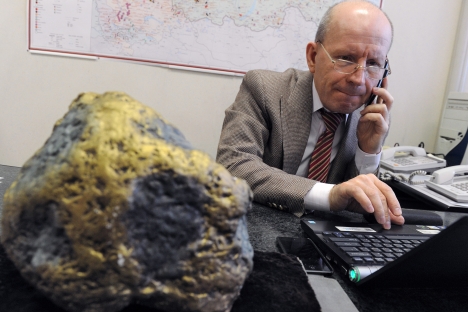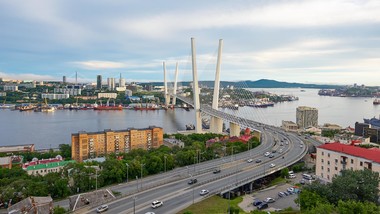Russia searches for a new Klondike

Increased production in 2012 made Russia the world’s fourth-largest gold producer, and many proven reserves are still untapped. Now Russian firms are ramping up production in Siberia and the Far East. Source: Shutterlock / Legion Media
{***Russia searches for a new Klondike by Viktor Kuzmin, special to RBTH***}
By Viktor Kuzmin, special to RBTH
Last summer, a new addition was made to the world’s collection of unique gold ingots. A heart-shaped gold nugget weighing 2.4 pounds was found in Russia’s Irkutsk Region. Irkutsk, located in central Siberia, is the fifth-largest region in Russia and is the country’s second-largest gold-producing area. It is home to one-fifth of the country’s gold production facilities.
Were it not for the unique shape of the nugget, however, the find would hardly have made the headlines. The weight of the little heart is only a tiny fraction of the 250 tons of gold produced in Russia every year.
Russia is the fourth-largest gold producer in the world, after China, Australia and the United States, but it ranks second in the world in terms of proven reserves. Although the sector is highly fractured — more than 600 companies work in gold production in Russia — the industry has its major players. The country’s biggest producer is Polyus Gold, which is also one of the top 10 gold producers in the world.
According to the official statistics from Russia’s state statistics agency, Rosstat, in 2012 Russian companies increased year-on-year gold production by 8.3 percent. Polyus, for its part, increased production of refined gold 12 percent and is anticipating even better numbers for 2013 — in particular, the company has said it expects to produce 1.8 million ounces of gold in 2013, up from 1.68 million in 2012.
The lion’s share of Russia’s gold comes from the extraction of mineral resources, which was up 6.3 percent in 2012 to 200 tons. Gold also comes into circulation through the recycling of scrap and waste.
In the past year, nearly all of Russia’s gold-producing areas reported growth in production. Numbers were particularly strong in the Krasnoyarsk Territory and the Irkutsk, Magadan and Chelyabinsk Regions. There was a drop in output at the Kupol Deposit in the Chukotka Autonomous Region in the Far East, but the Prime news agency reported that the decrease was a result of a known reduction of gold content in processed ore there.
Gold production is likely to increase throughout 2013, which could result in Russia overtaking the United States as the third-largest gold producing country in the world by volume.
Commenting on the numbers, Investcafe analyst Andrei Schenck noted that the increase in production was due to more output from existing facilities rather than new ones coming online, and that Russia’s potential for gold production is far from exhausted. “Some projects have been implemented, while others are still in the development stage,” Schenck said.
In 2014, production is scheduled to begin at Russia’s largest gold deposit, Polyus Gold’s Natalka. Although Natalka was discovered during World War II, it sat idle for many years due to its remote location in the Magadan Region, in the northern corner of Russia’s Far East. Once production begins at the facility, Natalka will process 11 million tons of ore and produce 16.5–22 tons of gold per year.
A gold mine is also under construction at the neighboring Pavlik deposit. Another 7.3 tons of gold a year are expected to be produced at this site, which is under the management of the metals investment firm Arlan. From mine to market
However, general market instability and the volatility of the gold market in particular have thwarted a number of major deals in Russia. The merger of Polyus Gold and Polymetal International, for example, failed to go ahead, and not a single mining or metals company issued an I.P.O. in 2012. The government also shelved an auction for Sukhoi Log, one of the country’s largest undeveloped gold deposits.
Still, Valentina Bogomolova, a senior analyst for metals and mining at Uralsib Capital, said that the current financial climate bodes well for gold mining in Russia. The global price of gold has increased steadily since 2000, and Goldman Sachs has predicted a rise in the price of one ounce of gold from the current $1,690 to $1,825 by the second quarter of 2013.
As a result, it is likely that the percentage of gold held in international reserves is likely to increase as well. Russia, for its part, has been stockpiling gold as a hedge against international financial instability. In 2007, the Russian government held 443 tons of gold in its strategic reserves; by Fall 2012, the number had increased to 1,028 tons.
In 2012, gold prices rose by 7 percent year-on-year, but some observers say that this level of growth is unlikely in 2013. One of the main factors has been the increased use of the metal to pay for energy supplies between Iran and Turkey, as well as higher demand from India. Indian jewelry manufacturers are trying to increase their supplies of gold before the import tax is raised this year, according to analysts at U.B.S.
Bogomolova said that demand for gold from Russian jewelry manufacturers is also likely to increase in 2013. According to Bogomolova, while Russian investors do not view pure gold as a way to accumulate capital, individuals consider jewelry to be a good investment while the dollar and the euro remain volatile.
{***Russia's gold industry needs to attract investors by Alexei Boyarsky, Kommersant-Money***}
Russia's gold industry needs to attract investors
By Alexei Boyarsky, Kommersant-Money
Sergei Kashuba, chairman of the Russian Union of Gold Producers, spoke with Alexei Boyarsky of Kommersant-Money about what needs to be done to keep production rates up and how to attract investors to Russia’s gold industry.

Sergei Kashuba, chairman of the Russian Union of Gold Producers. Source: Kommersant
Kommersant-Money: What drives growth in the price of gold?
Sergei Kashuba: The main driver is investors at all levels. In times of instability, everyone buys the metal. Demand heats up further when exchange traded funds (E.T.F.) appear in the precrisis period, with shares backed up by physical metal. Our Central Bank is also buying up gold: under its own internal regulation, at least 10 percent of foreign exchange reserves must be held in the form of bullion, and as of July 1, 2012, gold reserves stood at 936 metric tons (1,031 tons).
Kommersant-Money: At the current rate of production, gold should last for more than 40 years. Why are Russian gold producers buying foreign assets?
S. K.: There are no new licenses to be allocated. There is one strategic deposit at Sukhoi Log in the Irkutsk region, but it hasn’t been distributed yet. Other new sites simply do not exist.
Over the past 25–30 years, the world has adopted the practice of division of labor.
Large mining companies that develop ore deposits focus on production, gradually buying up more and more assets. But those same assets — prospected deposits with proven reserves and a ready development plan — are sold by minority shareholders called junior companies. In Mexico, for example, junior companies perform 80 percent of exploratory drilling; in Canada the figure is 70 percent; in Russia, just 10 percent.
Kommersant-Money: Why don’t foreign junior companies come to Russia?
S. K.: In the 1990s, there were about 30–40 foreign juniors operating in Russia; but now there are no more than a dozen. Today, according to Russian law, firms more than 25 percent foreign-owned cannot be awarded licenses to large deposits. There are problems associated with converting exploration licenses into production ones, which also affect domestic companies. Therefore, such junior companies more often than not look elsewhere.
If nothing is done to reverse the trend, in 10–15 years production rates will have dropped significantly. As old deposits become depleted, increasing amounts of ore are required to maintain production levels.
Kommersant-Money: We have huge untapped territories in Eastern Siberia. Could there be a new Klondike?
S. K.: The word “suddenly” is not part of geologists’ vocabulary. Before every discovery comes exploration. We need to create the right conditions to attract investors willing to invest in junior companies. First, the regulatory framework needs revising, in particular the issue of converting exploration licenses into production ones.
Second, in the absence of major venture capital funds, the government itself must fulfill the role of anchor investor by setting up a fund or creating a state corporation. Otherwise, Russian geology will see no investment at all, and domestic gold producers will start looking abroad.
First published in Russian in the Kommersant-Money magazine.
{***Pink or white, it's all still gold by Ilya Shvedkov***}
Pink or white, it’s all still gold
By Ilya Shvedkov, special to RBTH
 |
| Moscow jewelry stores are starting to stock yellow-white gold. Source: Reuters |
Russian gold traditionally has a pink tinge, but consumers are increasingly enamored of white gold, which is more common in other parts of the world.
In recent years, jewelry stores have displayed gold of all kinds of different hues: yellow, pink, white, green, blue and even black. To achieve the necessary color, jewelers carefully select the right combination of alloys.
For instance, to obtain a green tint, gold is alloyed with a small amount of silver, while a slightly larger proportion imparts a yellow-white shade. To obtain white gold, the composition of alloys includes nickel, platinum, or palladium.
Historically, Russian gold has a red or pink color, the result of its alloying with copper. However, according to Andrei Shenk, an analyst at InvestCafe, white and yellow gold more common in other parts of the world has made some serious inroads into the market recently, and the trend is likely to increase.
Shenk’s opinion is reinforced by Svetlana Starodubova, manager of a Moscow jewelry store. “In Russia, women customers like variety,” she said.
A spokesperson for Adamas, Russia’s largest jewelry manufacturer, said that Moscow is the first Russian city to follow the Western fashion for lighter colored gold. The pink-toned traditional color is still the color of choice for buyers outside the capital.
Andrei Polyakov of Alrosa, Russia’s giant diamond producer, said that changes in Russian tastes are clear across the jewelry industry. In the 1990s, jewelry sales in the country were split between inexpensive trinkets and name-brand pieces; today, however, the market is being driven by mid-range items.
“A shift has taken place,” Polyakov said. “It’s already noticeable at international exhibitions, which now feature many professional jewelers from Russia in search of ornaments for their middle-class customers.”
All rights reserved by Rossiyskaya Gazeta.
Subscribe
to our newsletter!
Get the week's best stories straight to your inbox






